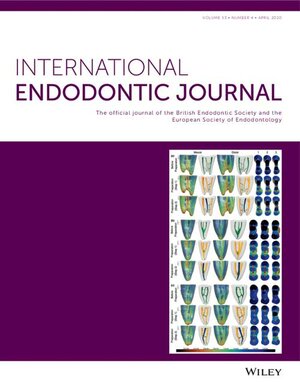The clinical outcomes of vital intact teeth close to large cystic lesions of endodontic origin: A prospective clinical study
Abstract
Aim
To evaluate the indication of the endodontic treatment for vital intact teeth with the root apex involved in large radicular cystic lesions of endodontic origin.
Methodology
This prospective cohort study enrolled healthy participants with radicular cysts of endodontic origin and with the root apex of vital intact teeth involved in the bone defect, as determined by cone beam computed tomography (CBCT). Thirty-two sound vital teeth were analysed by thermal (TPT) and electric pulp tests (EPT) before surgery (T0) and 1 week (T1), 2 weeks (T2), 3 months (T3) and 6 months (T4) post-surgery. Student's t-test (p < .05) was used to compare the EPT values at baseline and T4. anova (p < .05) was used to analyse the EPT variations for all maxillary and mandibular teeth. McNemar test (p < .05) was used to compare the results according to variation in EPT values gathering by variation, no variation and no response.
Results
At T1, 75 and 65.7% of teeth responded positively whilst 25 and 34.3% did not respond to EPT and TPT, respectively. The variation of the EPT values between T0 and T1 was observed for 50.0% of teeth, whilst no variation was noticed in 25.0% of teeth. At T4, 90.6 and 87.5% of teeth responded positively whilst 9.4 and 12.5% did not respond to EPT and TPT, respectively. At T4, variation of the EPT values between T0 and T4 was observed for 28.1%, whilst no variation was noticed in 62.5% of teeth. There were no statistical differences in EPT results between T0 and T4 (p > .05), but significant differences were observed for EPT values between T1 and T4 (p < .05), and between mandibular and maxillary teeth. The pulp sensibility of maxillary teeth worsened after surgery, before reverting progressively to T0 values, whilst no statistically significant differences were observed for mandibular teeth at the different time points.
Conclusions
These data support the inconsistence of the prophylactic endodontic treatment in healthy vital teeth with apex involvement in large cystic lesions of endodontic origin. Post-surgery follow-up with TPT and EPT is recommended to assess pulp status.

 求助内容:
求助内容: 应助结果提醒方式:
应助结果提醒方式:


